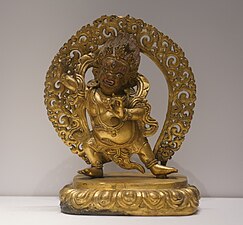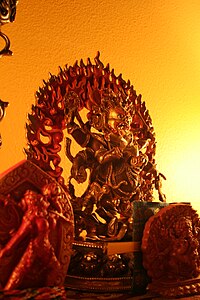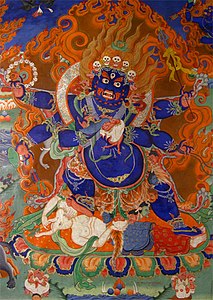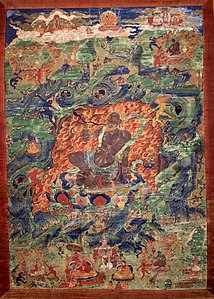Mahakala
| Mahakala | |
|---|---|
God of Time, Maya, Creation, Destruction and Power | |
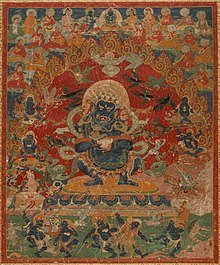 Mahākāla and companions | |
| Affiliation | Shiva |
| Abode | Śmaśāna (but varies by interpretation) |
| Weapon | Khanda, Trishula, Hammer (in Japanese depictions) |
| Consort | Parvati as Mahakali |
Mahākāla (Sanskrit: महाकाल) is a deity common to Hinduism and Buddhism.[1]
In Buddhism, Mahākāla is regarded as a Dharmapāla ("Protector of the Dharma") and a wrathful manifestation of a Buddha, while in Hinduism, Mahākāla is a fierce manifestation of the Hindu god Shiva and the consort of the goddess Mahākālī;[1] he most prominently appears in the Kalikula sect of Shaktism.[2][3][4]
Mahākāla appears as a protector deity in the various traditions of Vajrayana Buddhism, like Chinese Esoteric Buddhism, Shingon, and Tibetan Buddhism.[1] He is known as Dàhēitiān and Daaih'hāktīn (大黑天) in Mandarin and Cantonese, Daeheukcheon (대흑천) in Korean, Đại Hắc Thiên in Vietnamese, and Daikokuten (大黒天) in Japanese.
Etymology
Mahākāla is a Sanskrit bahuvrihi of mahā "great" and kāla "time/death", which means "beyond time" or death.[5]
Tibetan: ནག་པོ་ཆེན་པོ།, THL: nak po chen po means "Great Black One". Tibetan: མགོན་པོ།, THL: gön po "Protector" is also used to refer specifically to Mahākāla.
Description


According to Shaktisamgama Tantra, the spouse of
Both Mahākāla and Kālī represent the ultimate destructive power of
Mahākāla is typically depicted blue or black in colour. Just as all colours are absorbed and dissolved into black, all names and forms are said to melt into those of Mahākāla, symbolising his all-embracing, comprehensive nature. Black can also represent the total absence of colour, and again in this case it signifies the nature of Mahākāla as
In Hinduism
Mahakala is also known as
In Buddhism
Numerous traditions of
Mahakala is commonly regarded as the emanation of different beings in different cases, such as Hevajra, Vajradhara, Amitabha, and Avalokiteshvara or Akshobhya Buddha.[11][12] Different tantric cycles, like Guhyasamaja and Chakrasamvara, each contain Mahakala as an emanation of their central Buddha deity.[12]
Mahakala is almost always depicted with a crown of five skulls, which represent the transmutation of the five
The most notable variation in Mahakala's manifestations and depictions is in the number of arms, but other details can vary as well. For instance, in some cases there are Mahakalas in white, with multiple heads, without genitals, standing on varying numbers of various things, holding various implements, with alternative adornments, and so on.
Tibetan Buddhism depictions
Two-armed forms
The two-armed "Black-Cloaked Mahakala" (Wylie: mgon po ber nag chen) is a protector of the Karma Kagyu school clad in the cloak of a māntrika "warlock". His imagery derives from terma of the Nyingma school and was adopted by the Karma Kagyu during the time of Karma Pakshi, 2nd Karmapa Lama. He is often depicted with his consort, Rangjung Gyalmo. He is often thought to be the primary protector, but he is in fact the main protector of the Karmapas specifically. Four-Armed Mahakala is technically the primary protector. Six-Armed Mahakala (Wylie: mgon po phyag drug pa) is also a common dharmapala in the Kagyu school.
Pañjaranātha Mahakala "Mahakala, Lord of the Tent", an emanation of
-
A Nepalese statue of Mahakala Bernagchen (Black Cloak Mahakala), the protector of the Karmapas.
-
Black-Cloaked Mahākāla
-
Mahakala "Protector of the Tent", Central Tibet, circa 1500.
-
Tibetan Mahakala sculpture.
-
Tibetan Mahakala at National Museum, New Delhi, India
Four-armed forms
There are various Four-Armed Mahakalas (Skt. Chaturbhūjamahākāla, Wylie: mgon po phyag bzhi pa, "The Great Black Vajra Lord with Four Hands"), one popular depiction comes from the Arya linegae of Guhyasamaja.[12]
These are the primary protectors of the
-
Mahakala, 12th century, Rubin Museum of Art
-
Exhibit in the Asian collection of the American Museum of Natural History, Manhattan, New York City, New York, USA.
Six-armed forms
Nyingshuk came from Khyungpo Nenjor, the founder of the
lineages of various forms of Six-Armed Mahakala. Nyinghsuk, though derived from the Shangpa, is not the major Shangpa one; it is in a dancing posture rather than upright, and is a very advanced Mahakala practice.The White Six-Armed Mahakala (Skt: Ṣadbhūjasītamahākāla; Wylie: mgon po yid bzhin nor bu) is popular among Mongolian Gelugpas.
-
A rūpa of a six-armed Mahākāla
-
Six-Armed Mahakala, Likir Gompa, Ladakh
-
Tibetan Black Six-Armed Mahakala
Other forms
-
Mahakala in the Form of a Brahman
-
A red Mahakala
In China


Mahākāla is mentioned in many
He eventually became the center of a flourishing cult after the 9th century in the kingdoms of
In some texts, Mahākāla is described as a fearsome god, a "demon who steals the vital essence (of people)" and who feeds on flesh and blood, though he is also said to only devour those who committed sins against the
One story found in the Tang-era monk
As time went by, Mahākāla also became seen as a guardian of Buddhist monasteries, especially its kitchens. The monk Yijing, who traveled to Srivijaya and India during the late 7th century, claimed that images of Mahākāla were to be found in the kitchens and porches of Indian Buddhist monasteries, before which offerings of food were made:[21]
There is likewise in great monasteries in India, at the side of a pillar in the kitchen, or before the porch, a figure of a deity carved in wood, two or three feet high, holding a golden bag, and seated on a small chair, with one foot hanging down towards the ground. Being always wiped with oil its countenance is blackened, and the deity is called Mahākāla [莫訶哥羅, pinyin: Mòhēgēluō, M.C. (Baxter): mak xa ka la] or the great black deity [大黑神, pinyin: Dàhēishén, M. C. (Baxter): dɑH xok zyin]. The ancient tradition asserts that he belonged to the beings (in the heaven) of the great god (or Maheśvara). He naturally loves the Three Jewels, and protects the five assemblies from misfortune. Those who offer prayers to him have their desires fulfilled. At meal-times those who serve in the kitchen offer light and incense, and arrange all kinds of prepared food before the deity. (...) In China the image of that deity has often been found in the districts of Kiang-nan, though not in Huai-poh. Those who ask him (for a boon) find their wishes fulfilled. The efficacy of that deity is undeniable.[22]
In China, the god was also associated with fertility and sexuality: during the Qixi Festival (a.k.a. the Double Seventh Festival) held on the 7th day of the 7th month of the Chinese calendar, married women traditionally bought dolls or figurines called 'Móhéluó' (魔合羅) or 'Móhóuluó' (摩睺羅) - the term probably deriving from 'Mahākāla' - in the hopes of giving birth to a child.[23][24][25]
Ritual texts also prescribe the worship of Mahākāla to women looking for a male partner or to pregnant women.[23]
In addition, he is also commonly invoked as a protective deity in certain mantras, such as the Śūraṅgama Mantra and the Mahamayuri-vidyarajñi-dharani contained in the Mahamayuri Vidyarajñi Sutra, which are popular in Chan Buddhism tradition.[26][27]
-
Dàhēitiān (center) flanked by theMañjuśrī (right). Baocheng Temple, Hangzhou, Zhejiang, China
-
Qing dynasty statuette of Dàhēitiān. China, 17th Century
-
Ming dynasty statue of Dàhēitiān. Sichuan, China. 14th Century (with pedestal from the 16th century)
In Japan

Mahakala (known as Daikokuten 大黑天) enjoys an exalted position as a household deity in Japan, as he is one of the Seven Lucky Gods in Japanese folklore.
The Japanese also use the symbol of Mahakala as a monogram. The traditional pilgrims climbing the holy Mount Ontake wear tenugui on white Japanese scarves with the Sanskrit seed syllable of Mahakala.
In Japan, this deity is variously considered to be the god of wealth or of the household, particularly the kitchen. He is recognised by his wide face, smile, and a flat black hat, in stark contrast to the fierce imagery portrayed in Tibetan Buddhist art. He is often portrayed holding a golden mallet, otherwise known as a magic money mallet, and is seen seated on bales of rice, with mice nearby (mice signify plentiful food).
In Sikhism

In Sikhism Mahakal (ਮਹਾਕਾਲ) is used to refer to God. In the text Dasam Granth, which is attributed to Guru Gobind Singh,[28] Mahakal is applied as a name of God to emphasize his supremacy over all beings. In the section titled Bachittar Natak, It states that in a previous incarnation the author was a sadhu meditating in the Himalayan foothills on Mahakal before being called to take birth as Guru Gobind Singh.[29] Further verses the praise Mahakal. Verse 434 of the Chaubis Avtar section states:
I will not first honor Ganesha [Ganesa], nor do I ever meditate upon Krishna or Vishnu (kisan bisan).
I have heard of but do not recognize them. I am absorbed in contemplation at His feet. (434)
Mahakal is my protector...[30]
See also
References
Citations
- ^ a b c Bryson (2017), p. 42.
- ^ a b Magee (n.d.).
- ^ a b Bhattacharya Saxena (2011).
- ^ a b Johnson (2009), p. [page needed].
- ^ Mookerjee (1988), p. [page needed].
- ^ Snyder (2001), p. 76.
- ^ Bowker (2000), p. [page needed].
- ^ Coulter & Turner (2021), p. 99.
- ^ Eck (2012), p. 237.
- ^ "Mahakala, Protector of the Tent | Central Tibet". The Metropolitan Museum of Art. Retrieved 2023-11-25.
- ^ a b c "Buddhist Protector: Mahakala Main Page". www.himalayanart.org. Retrieved 2023-11-25.
- ^ a b c d Rana (2019)
- ^ Faure (2015b), pp. 46–47.
- ^ Howard et al. (2006), p. 416.
- ^ Faure (2015b), pp. 45–46.
- ^ Faure (2015a), p. 195.
- ^ Faure (2015b), pp. 117–118.
- ^ "荼枳尼天 (Dakiniten)". Flying Deity Tobifudō (Ryūkō-zan Shōbō-in Official Website). Retrieved 2021-04-08.
- ^ Amoghavajra (n.d.).
- ^ Iyanaga (2008).
- ^ Faure (2015b), p. 49.
- ^ I-Tsing (1896), pp. 38–39.
- ^ a b Faure (2015b), pp. 52–53.
- ^ Johnson (2021), p. 157.
- ^ Hsia, Kao & Li (2014), p. 147.
- ^ Hsüan Hua (2009), p. xviii.
- ^ Keyworth (2016).
- ISBN 978-81-7010-301-1.
- ^ Rinehart (2011), pp. 26–27.
- ^ Rinehart (2011), pp. 29–31.
Works cited
- Amoghavajra (n.d.). "仁王護國般若波羅蜜多經 護国品第五 - T. 0246". SAT Daizokyo Text Database. Retrieved 2021-04-21.
- Bhattacharya Saxena, Neela (2011). "Gynocentric Thealogy of Tantric Hinduism: A Meditation Upon the Devi". ISBN 978-0199273881. (subscription or UK public library membershiprequired)
- Bowker, John (2000). "The Concise Oxford Dictionary of World Religions". ISBN 978-0-19-280094-7. (subscription or UK public library membershiprequired)
- Bryson, Megan (2017). "Between China and Tibet: Mahākāla Worship and Esoteric Buddhism in the Dali Kingdom". In Bentor, Yael; Shahar, Meir (eds.). Chinese and Tibetan Esoteric Buddhism. Studies on East Asian Religions. Vol. 1. ISSN 2452-0098.
- Coulter, Charles Russell; Turner, Patricia (2021). Encyclopedia of Ancient Deities. McFarland. ISBN 978-0-7864-9179-7.
- Eck, Diana L. (2012). India: A Sacred Geography. Harmony/Rodale. ISBN 978-0-385-53191-7.
- Faure, Bernard (2015a). The Fluid Pantheon: Gods of Medieval Japan. Vol. 1. University of Hawaii Press.
- Faure, Bernard (2015b). Protectors and Predators: Gods of Medieval Japan. Vol. 2. University of Hawaii Press.
- Howard, Angela Falco; Li, Song; Wu, Hung; Yang, Hong (2006). Chinese Sculpture. Yale University Press. ISBN 9780300100655.
- Hsia, Chih-tsing; Kao, George; Li, Wai-yee, eds. (2014). "The Moheluo Doll (Meng Hanqing)". The Columbia Anthology of Yuan Drama. Translated by Jonathan Chaves. Columbia University Press.
- Hsüan Hua (2009). The Śūraṅgama Sūtra: A New Translation. Translated by Buddhist Text Translation Society. Ukiah, CA, USA: Buddhist Text Translation Society. ISBN 978-0881399622.
- I-Tsing (1896). A Record of the Buddhist Religion as Practised in India and the Malay Archipelago. Translated by J. Takakusu. Oxford: Clarendon Press.
- Iyanaga, Nobumi (2008). "Under the Shadow of the Great Śiva: Tantric Buddhism and its Influence on Japanese Mediaeval Culture". academia.edu. Retrieved 2021-04-21.
- Johnson, Dale (2021). A Glossary of Words and Phrases in the Oral Performing and Dramatic Literatures of the Jin, Yuan, and Ming. University of Michigan Press. ISBN 978-0472038237.
- Johnson, W. J (2009). "A Dictionary of Hinduism". ISBN 978-0198610250. (subscription or UK public library membershiprequired)
- Keyworth, George A. (2016). "Zen and the "Hero's March Spell" of the Shoulengyan jing". The Eastern Buddhist. 47 (1): 81–120. JSTOR 26799795.
- Magee, Mike (tr.) (n.d.). "Śrī Mahākāla Deva". ShivaShakti.com. Retrieved 7 July 2016.
- Mookerjee, Ajit (1988). Kali: The Feminine Force. Thames and Hudson. ISBN 978-0500275054.
- Rana, Poonam R. L. (2019). "The sacred Mahakala in the Hindu and Buddhist texts". Nepalese Culture. XIII. Kathmandu, Nepal: Tribhuvan University: 77–94. . Retrieved 2023-03-08.
- Rinehart, Robin (2011). Debating the Dasam Granth. ISBN 978-0-19-984247-6.
- Snyder, William H. (2001). Time, Being, and Soul in the Oldest Sanskrit Sources. Global Academic Publishing. ISBN 978-1586840723.
Further reading
- Carroll, Michael (Winter 2004). "Mahakala At Work: Learn to handle conflict skillfully, from the watercooler to the boardroom". Tricycle. Retrieved 2023-03-08.
- Dahlke, Paul (1913). Routledge Revivals: Buddhist Stories. Routledge. ISBN 9781351969659. Retrieved 16 March 2017.
- Jansen, Eva Rudy (1990). The Book of Buddhas: Ritual Symbolism Used on Buddhist Statuary and Ritual Objects. Binkey Kok Publications.
- Kalsang, Ladrang (2003). The Guardian Deities of Tibet. Translated by Pema Thinley. Winsome Books India. ISBN 81-88043-04-4.
- Lewis, Todd (2000). Popular Buddhist Texts From Nepal Narratives and Rituals of Newar Buddhism. State University of New York Press. ISBN 978-0791492437.
- Linrothe, Rob (1999). Ruthless Compassion: Wrathful Deities in Early Indo-Tibetan Esoteric Buddhist Art. London: Serindia Publications. ISBN 0-906026-51-2.
- Pal, Pratapaditya (1986). Indian Sculpture: Circa 500 B.C.-A.D. 700. Los Angeles County Museum of Art. ISBN 978-0520059924.
- Soifer, Deborah A. (1991). The Myths of Narasimha and Vamana: Two Avatars in Cosmological Perspective. SUNY Press. ISBN 978-0791407998.
- Stablein, W. G. (1976). The Mahākālatantra: A Theory of Ritual Blessings and Tantric Medicine (Thesis). Columbia University. OCLC 3801907.
- Stablein, William (1991). Healing Image: The Great Black One. Berkeley-Hong Kong: SLG Books. ISBN 0-943389-06-2.





